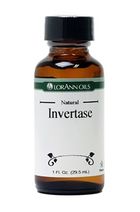Invertase: Difference between revisions
Uncle Jesse (talk | contribs) Adding image |
Uncle Jesse (talk | contribs) No edit summary |
||
| Line 2: | Line 2: | ||
From [https://en.wikipedia.org/wiki/Invertase Wikipedia]: | From [https://en.wikipedia.org/wiki/Invertase Wikipedia]: | ||
Invertase is an [[enzyme]] that catalyzes the [[hydrolysis]] (breakdown) of [[sucrose]] (table sugar). Alternate names for invertase include EC 3.2.1.26, saccharase, glucosucrase, beta-h-fructosidase, beta-fructosidase, invertin, sucrase, maxinvert L 1000, fructosylinvertase, alkaline invertase, acid invertase, and the systematic name: beta-fructofuranosidase. The resulting mixture of [[fructose]] and [[glucose]] is called inverted sugar syrup. Related to invertases are sucrases. Invertases and sucrases hydrolyze sucrose to give the same mixture of glucose and fructose. Invertases cleave the O-C(fructose) bond, whereas the sucrases cleave the O-C(glucose) bond. | Invertase is an [[enzyme]] that catalyzes the [[hydrolysis]] (breakdown) of [[sucrose]] (table sugar). Alternate names for invertase include EC 3.2.1.26, saccharase, glucosucrase, beta-h-fructosidase, beta-fructosidase, invertin, sucrase, maxinvert L 1000, fructosylinvertase, alkaline invertase, acid invertase, and the systematic name: beta-fructofuranosidase. The resulting mixture of [[fructose]] and [[glucose]] is called inverted sugar syrup. Related to invertases are sucrases. Invertases and sucrases hydrolyze sucrose to give the same mixture of glucose and fructose. Invertases cleave the O-C (fructose) bond, whereas the sucrases cleave the O-C (glucose) bond. | ||
For industrial use, invertase is usually derived from [[yeast]]. It is also synthesized by bees which use it to make [[honey]] from nectar. Optimal temperature at which the rate of reaction is at its greatest is 140°F (60°C) and an optimum [[pH]] of 4.5. | For industrial use, invertase is usually derived from [[yeast]]. It is also synthesized by bees which use it to make [[honey]] from nectar. Optimal temperature at which the rate of reaction is at its greatest is 140°F (60°C) and an optimum [[pH]] of 4.5. | ||
Revision as of 00:30, 22 September 2017

From Wikipedia:
Invertase is an enzyme that catalyzes the hydrolysis (breakdown) of sucrose (table sugar). Alternate names for invertase include EC 3.2.1.26, saccharase, glucosucrase, beta-h-fructosidase, beta-fructosidase, invertin, sucrase, maxinvert L 1000, fructosylinvertase, alkaline invertase, acid invertase, and the systematic name: beta-fructofuranosidase. The resulting mixture of fructose and glucose is called inverted sugar syrup. Related to invertases are sucrases. Invertases and sucrases hydrolyze sucrose to give the same mixture of glucose and fructose. Invertases cleave the O-C (fructose) bond, whereas the sucrases cleave the O-C (glucose) bond.
For industrial use, invertase is usually derived from yeast. It is also synthesized by bees which use it to make honey from nectar. Optimal temperature at which the rate of reaction is at its greatest is 140°F (60°C) and an optimum pH of 4.5.